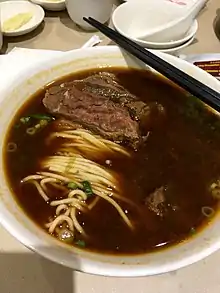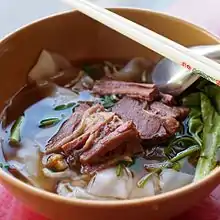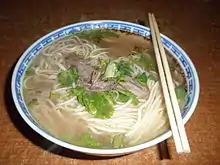Beef noodle soup
Beef noodle soup is a noodle soup made of stewed or red braised beef, beef broth, vegetables and Chinese noodles. It exists in various forms throughout East and Southeast Asia. The clear broth beef noodle soup was allegedly invented by the Hui people during the Tang dynasty and is commonly known as Lanzhou beef noodle soup.[1][2] The Sichuan beef noodle soup or red-braised beef noodle soup (紅燒牛肉麵), was first created by Kuomintang veterans in Taiwan;[3][4][5][6][7][8][9][10] this variation became commonly known as Taiwanese beef noodle soup.
 Beef noodle soup from Singapore | |
| Type | Noodle soup |
|---|---|
| Region or state | Mainland China, Taiwan, Southeast Asia |
| Main ingredients | Beef, beef broth, vegetables, Chinese noodles |
| Beef noodle soup | |||||||||||||||||||||||||
|---|---|---|---|---|---|---|---|---|---|---|---|---|---|---|---|---|---|---|---|---|---|---|---|---|---|
| Traditional Chinese | 牛肉麵 | ||||||||||||||||||||||||
| Simplified Chinese | 牛肉面 | ||||||||||||||||||||||||
| Literal meaning | Beef noodles | ||||||||||||||||||||||||
| |||||||||||||||||||||||||
In overseas Chinese communities in North America, this food can be found in Chinese restaurants. In Mainland China, a large bowl of it is often taken as a whole meal with or without any side dish. In Taiwan, beef noodle vendors may also have optional, often cold side dishes, such as braised dried tofu, seaweed or pork intestine. Beef noodles are often served with suan cai (Chinese sauerkraut) on top, green onion and sometimes other vegetables in the soup as well.[11]
Beef noodles are often served as fast food in mainland China, with Mr. Lee being the largest chain. In Taiwan, it is sometimes considered a national dish and every year Taipei holds an annual Beef Noodle Festival, where various chefs and restaurants compete for the title of the "best beef noodles in Taiwan".[12][13] Due to influences from the influx of immigrants from mainland China in the early 1900s, the Taiwanese version of beef noodle soup is now one of the most popular dishes in Taiwan.[14]
Variations
In Chinese, "牛肉麵" literally means "beef noodles". Mainland Chinese and Hong Kong restaurants may have a tendency to distinguish between "牛肉麵" "beef noodles" and "牛腩麵" "beef brisket noodles", with the former containing either beef shank or beef slices and the latter containing only brisket. It is sometimes served with wontons. In Taiwan, "牛肉麵" typically consists of either brisket or shank only, though many restaurants also have tendon or a more expensive option with both meat and tendon (Chinese: 半筋半肉麵; lit. 'half tendon half meat noodle') and occasionally with tripe; 三寶麵; 'three-treasure noodle', usually denotes a bowl containing all three. If one orders "牛肉湯麵" or "beef soup noodles" in a restaurant in Taiwan, Mainland China or Hong Kong, they might be given a cheaper bowl of noodles in only beef broth but no beef. If one orders a "牛肉湯" or "beef-soup", they could be given a more expensive bowl of beef broth with chunks of beef in it but without noodles. In Tainan, beef soup (牛肉湯) denotes a distinct and local specialty, where sliced beef is blanched in hot soup and accompanied by shredded ginger.

There are two common variations of beef noodle which differ in the way the broth is prepared: braised beef noodle soup and clear broth beef noodle soup.
Clear broth beef noodles

.jpg.webp)
The Chinese Muslim style of beef noodle is also known as clear-broth or consommé-stewed beef noodle (清燉牛肉麵). It often uses halal (or qingzhen) meat and contains no soy sauce, resulting in a lighter taste that may be flavoured by salt and herbs. Local lore attributes its creation with a Hui Chinese man from Lanzhou named Ma Baozi.[15] In Lanzhou, Gansu, Lanzhou Beef Lamian (兰州牛肉面) is usually served with clear soup and one hand-pulled lamian noodle per bowl. In halal restaurants, only quality local beef from the Southern Yellow cattle (Chinese: 黃牛; lit. 'yellow cattle') prepared by the local halal butcher is used for the beef noodle.[16] Chinese radish and the specially cooked spicy oil are also indispensable partners to Lanzhou beef noodles. Together with hand-pulled noodle, clear soup and herbs, they are called "Yi Qing Er Bai San Hong Si Lu Wu Huang". "Yi Qing" literally translates to "One Clear", which is the soup. "Er Bai" means "Two White", which is Chinese radish. "San Hong" means "Three Red", which is spicy oil. "Si Lu" means "Four Green", which is the herb."Wu Huang" means "Five Yellow", which is the hand-pulled noodle.
Braised beef noodles
.jpg.webp)
When soy sauce is added, the soup is called red roasted or braised beef noodles (紅燒牛肉麵). Braised beef noodle soup was invented in Taiwan. It is sometimes referred to as "Sichuan Beef Noodle Soup" (四川牛肉麵), especially in Taiwan. The beef is often stewed with the broth and simmered, sometimes for hours. Chefs also let the stock simmer for long periods with bone marrow; some vendors can cook the beef stock for over 24 hours. The dish can also be found overseas as is the case in American Sichuanese restaurants.[17]
The dish was introduced to Taiwan by Kuomintang veterans from Sichuan province who fled from mainland China to Kaohsiung, Taiwan and served in military dependents' villages (which had a distinct cuisine from the rest of Taiwan). The Taiwanese traditionally had an aversion to the consumption of beef even into the mid-1970s because cattle were valuable beasts of burden so originally the dish was only eaten by the mainland Chinese. However, the dish became more accepted over time and is now one of Taiwan's most popular foods. It is believed that the popularity of this noodle soup broke the beef-eating taboo and also paved the way to Taiwan later embracing American foods that utilized beef (such as hamburgers). The Taiwanese variation is significantly less spicy than its Sichuanese predecessor and there are several variations with the soy-based broth, such as tomato, garlic and herbal medicine. The tomato variation (番茄牛肉麵) is popular in Taiwan and features chunks of tomatoes in a rich red-coloured tomato broth with or without soy sauce.[18] The herbal medicine variation is usually served without suancai as a topping (as its acidic properties are believed to exhibit medicinal properties) and may be accompanied by a chili paste made from beef lard.
Other varieties
In Thailand, kuaitiao nuea pueay is a similar dish. In Vietnam, Bò Kho is a beef stew sometimes served with noodles (or bread as an alternative), that is similar to Taiwanese braised beef noodles. Pho is also a Vietnamese noodle soup that contains broth, rice noodles called bánh phở, herbs and meat, primarily made with either beef (phở bò) or chicken (phở gà). In Philippines, Beef Mami is very popular and can also be combined with Pares.
Yaka mein is a type of beef noodle soup commonly found in Chinese restaurants in New Orleans. It consists of stewed beef, spaghetti noodles, hard-boiled egg and chopped green onions, with Cajun seasoning, chili powder or Old Bay-brand seasoning.
See also
References
- Lonely Planet Food, The World's Best Spicy Food, Lonely Planet, 2017
- Nate Tate, Feeding the Dragon: A Culinary Travelogue Through China with Recipes, Andrews McMeel Publishing, 2011
- Lonely Planet Food, The World's Best Spicy Food, Lonely Planet, 2017
- Nate Tate, Feeding the Dragon: A Culinary Travelogue Through China with Recipes, Andrews McMeel Publishing, 2011
- "Taiwanese Beef Noodles". Food Culture in Taiwan. Retrieved 26 September 2018.
- 四川」牛肉麵其實源自台灣?一窺牛肉麵的背後故事. Liberty Times Net. Liberty Times. Retrieved 26 September 2018.
- 焦, 桐. 一碗紅燒牛肉麵,喚醒許多人共同的歷史記憶. 遠見華人 精英論壇. Retrieved 26 September 2018.
- 台灣講古:翻轉本地口味的"川味"牛肉麵. BBC News. BBC News. Retrieved 26 September 2018.
- "MICHELIN Guide Taipei 2018 Bib Gourmand Selection: The Best Taiwanese Beef Noodles To Slurp Up". Michelin Guide. MICHELIN Guide. Retrieved 19 October 2019.
- "台灣獨特的川味牛肉麵 發跡六十年後帶動百億商機". Tai Sounds. TaiSounds. Retrieved 19 October 2019.
- "Taipei Beef Noodle Festival: Beef Noodle Tasting". tbnf.com.tw. Taipei Beef Noodle Festival. Archived from the original on 17 May 2011. Retrieved 6 December 2013.
- "Food Lovers Flock to Taipei Beef Noodle Festival". Focustaiwan.tw. Focus Taiwan News. Retrieved 6 December 2013.
- "2013 Taipei International Beef Noodle Festival". taipei.gov. Taipei City Government. Retrieved 6 December 2013.
- Goossaert, Vincent; David A. Palmer (2011). The Religious Question in Modern China. University of Chicago Press. pp. 281–283. ISBN 9780226304168.
- "Recipes of China: Lanzhou Beef Noodle Soup".
- "Taiwan Food Culture - Niuruo Mian (Beef Noodle)". taiwanfoodculture.net. Taiwan Food Culture News. Archived from the original on 18 December 2013. Retrieved 6 December 2013.
- "Sichuan noodles at sixty-one SFBA Sichuan restaurants".
- Lu, Yaodong. "What is Beef Noodle: Interview: Professor Lu, Yaodong, Expert in history of food and beverage". tbnf.com.tw. Taipei Beef Noodle Festival. Archived from the original on 17 May 2011. Retrieved 6 December 2013.


.jpg.webp)